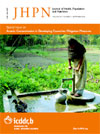
|
The Journal of Health, Population and Nutrition
icddr,b
ISSN: 1606-0997
EISSN: 1606-0997
Vol. 35, No. 1, 2016, pp. 1-12
|
 Bioline Code: hn16031
Bioline Code: hn16031
Full paper language: English
Document type: Research Article
Document available free of charge
|
|
|
The Journal of Health, Population and Nutrition, Vol. 35, No. 1, 2016, pp. 1-12
| en |
Water Quality Index for measuring drinking water quality in rural Bangladesh: a crosssectional study
Akter, Tahera; Jhohura, Fatema Tuz; Akter, Fahmida; Chowdhury, Tridib Roy; Mistry, Sabuj Kanti; Dey, Digbijoy; Barua, Milan Kanti; Islam, Md Akramul & Rahman, Mahfuzar
Abstract
Background: Public health is at risk due to chemical contaminants in drinking water which may have immediate
health consequences. Drinking water sources are susceptible to pollutants depending on geological conditions and
agricultural, industrial, and other man-made activities. Ensuring the safety of drinking water is, therefore, a growing
problem. To assess drinking water quality, we measured multiple chemical parameters in drinking water samples
from across Bangladesh with the aim of improving public health interventions.
Methods: In this cross-sectional study conducted in 24 randomly selected upazilas, arsenic was measured in drinking
water in the field using an arsenic testing kit and a sub-sample was validated in the laboratory. Water samples were
collected to test water pH in the laboratory as well as a sub-sample of collected drinking water was tested for water
pH using a portable pH meter. For laboratory testing of other chemical parameters, iron, manganese, and salinity,
drinking water samples were collected from 12 out of 24 upazilas.
Results: Drinking water at sample sites was slightly alkaline (pH 7.4 ± 0.4) but within acceptable limits. Manganese
concentrations varied from 0.1 to 5.5 mg/L with a median value of 0.2 mg/L. The median iron concentrations in water
exceeded WHO standards (0.3 mg/L) at most of the sample sites and exceeded Bangladesh standards (1.0 mg/L) at a
few sample sites. Salinity was relatively higher in coastal districts. After laboratory confirmation, arsenic concentrations
were found higher in Shibchar (Madaripur) and Alfadanga (Faridpur) compared to other sample sites exceeding WHO
standard (0.01 mg/L). Of the total sampling sites, 33 % had good-quality water for drinking based on the Water Quality
Index (WQI). However, the majority of the households (67 %) used poor-quality drinking water.
Conclusions: Higher values of iron, manganese, and arsenic reduced drinking water quality. Awareness raising on
chemical contents in drinking water at household level is required to improve public health.
Keywords
Water quality index; Chemical parameters; WASH program; BRAC; Bangladesh
|
| |
© Copyright 2016 - The Journal of Health, Population and Nutrition
Alternative site location: http://www.jhpn.net
|
|
